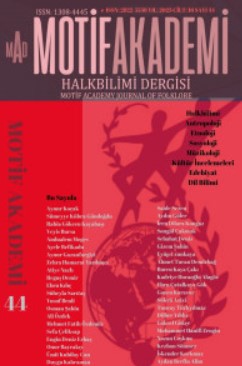TÜRK TASAVVUF MUSİKİSİNDE RİTMİN RİTÜELE DÖNÜŞÜMÜ -ŞANLIURFA ÇİFTELERİ-
TRANSFORMATION OF RHYTHM INTO RITUAL IN TURKISH SUFI MUSIC -ŞANLIURFA HYMNS-
Author(s): Songül ÇakmakSubject(s): Customs / Folklore, Music, Islam studies
Published by: Motif Halk Oyunları Eğitim ve Öğretim Vakfı
Keywords: Turkish music; Sufism; ritual; doubles; rhythm; Şanlıurfa;
Summary/Abstract: Rhythm, which emerged naturally before the formation of the first musical genres, is one of the ways of protection against visible and invisible supernatural forces by hitting objects together and is one of the most important tools that form the main skeleton of music. In the main axis of religious music, Shaman's entering into ecstasy with rhythm and dancing with rhythm is the source of an important transformation. Based on Mevlana's stories, the sema show, which occurs after ecstasy from the regular rhythm of gold beating, shows that the religious practice inherited from the Shaman continues spiritually and its continuity is ensured with its ritual dimension. The combination of tradition with culture and its continuation as an effective chain of belief varies depending on the basis and frequency of use in the spatial context. The study is about the realization of various rituals through doubles, based on the doubles recited by folk artists in the Şanlıurfa region. It was based on the questions of how Turkish Sufi music became widespread among the people under the name of Çifteler (hymn) and turned into sema, semah or dhikr, and which quality was effective in ensuring its continuity. Many of the people in the Sufi group called Çifte in Şanlıurfa are hafiz. Çifteler is usually performed with tambourine accompaniment. The modal structure gains variety with sound, thus ensuring the permanence and continuity of the lyrics. In addition to the modal features that make Turkish Music forms widespread among the public, it is also the power of diversity in rhythm to appeal to different emotions. Religious forms such as kaside, mawlid and hymns performed in different rhythms can be sustained due to their wide context. In this study, the effective power of belief in the transformation of rhythm into ritual, as well as the provider of social unity and solidarity, will be mentioned, and the roles of these musicians in the Şanlıurfa region in this formation, their contributions to the development of Turkish Classical Music / Turkish Folk Music genres, and their ability to use Turkish music in different forms will be mentioned. It was deemed appropriate to conduct netnographic research on this collective musical culture sharing, which traditionally transforms religious belief into action. This research method was preferred because the context in which the rituals take place is limited to the male autonomous area (dhikr) and different belief practices (Alevi semah) are closed to the public. Apart from these difficulties of context-centered approaches, the important role of the doubles in the transition between divan literature/folk literature, which combines two different types of music, has been tried to be explained by conducting oralsource interviews and scanning the literature.
Journal: Motif Akademi Halkbilimi Dergisi
- Issue Year: 16/2023
- Issue No: 44
- Page Range: 1859-1879
- Page Count: 21
- Language: Turkish

